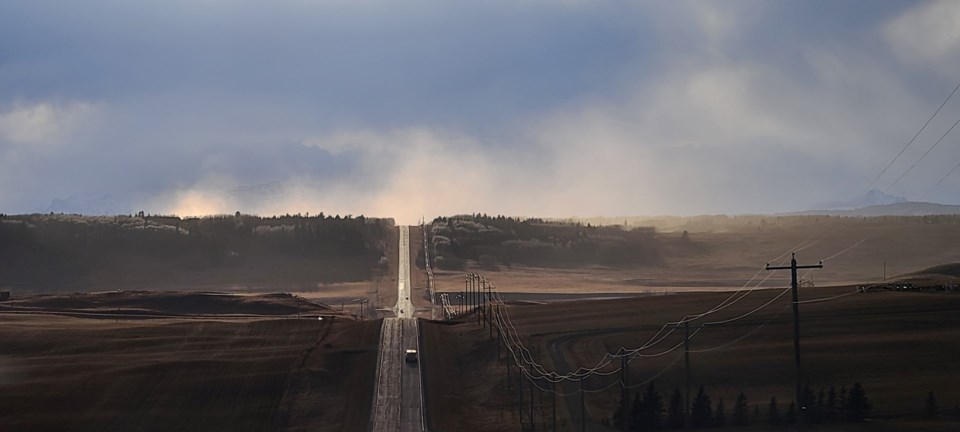Vivian Pharis has lived near the Alberta town of Cochrane for more than 50 years, not far from Big Hill Springs Provincial Park – one of the oldest in the province.
But she and fellow members of Bighill Creek Preservation Society worry that the “precious” little piece of nature is under threat from a huge nearby gravel mine proposal.
Big Hill Springs Provincial Park, established in 1957, is about 45 kilometres northwest of Calgary, just east of Cochrane. The road there from the city trundles along rolling hills, before cutting down into a valley where cattle graze on the steep hills that rise on either side.
Around 250,000 people visit the provincial park each year. When The Globe and Mail visited on a hot, dry Friday in August, about 10 cars lined the parking lot, mostly belonging to families.
Some visitors meandered the trails that loop past viewpoints, others picnicked, and a handful of giggling children splashed in the cool creek that flows through the park.
The source of that creek is the park’s namesake – Big Hill Springs. All year round water bubbles from the ground northwest of the main portion of the park. A Parks Canada study once declared the mineral springs as one of the top four in the country.
Ms. Pharis, vice-president of the preservation society, remembers when the park was more of a wild camping spot than a place with purpose-built walking trails.
It’s in Rocky View County, which encompasses bedroom and agricultural communities north of Calgary. Rocky View is the most populous rural municipality in Alberta, but much of the land is used for crops, ranches or industrial development.
“Almost none of it is in a condition that could be protected, or is still in its natural state,” Ms. Pharis said in an interview.
“So this little creek is kind of precious, because it’s largely still intact,” she said. Although the watershed is small, she said, ”it has this creek running through it, and it’s a snake of naturalness that’s still there.”
The preservation society has been fighting hard against the Summit Pit development proposed by Mountain Ash LP. Its members are worried that mining 25-metres deep and leaving only a one-metre gap between the bottom of the pit and the water table presents significant danger – hydrologist and geochemist Jon Fennell, who is a resident of Rocky View County, highlighted the risks in a report he prepared for the group.
Mountain Ash disputes those findings.
In a statement to The Globe, the company said hydrological and other experts reviewed the project plans to make sure it would have no measurable impact on groundwater resources, and therefore not jeopardize the springs, creek or the provincial park. Extraction also won’t occur within the water table, it added.
The project has gone through an extensive eight-year review process, the company said. The resulting approvals granted by Rocky View County and Alberta’s Ministry of the Environment and Protected Areas, the company said, make it “confident that the concerns raised during the approval process have been adequately addressed and that we have an environmentally sound and responsible project.”
Christa Jubinville, the assistant director of communications with the environment ministry, said that water quality and quantity concerns raised during the review process were assessed by hydrogeologists who looked closely at potential impacts on watersheds and nearby areas.
The Mountain Ash approvals, she said, include conditions to protect water quality and availability in the area around the site, including testing groundwater and surface water before gravel extraction starts, and monitoring closely while extraction is under way to make sure that there are no unintended impacts to the spring, creek, rock formations or wetlands.
Ms. Jubinville added that extraction would be halted if changes to water quality or quantity are detected that could impact the creek or provincial park.
Those who oppose the project unsuccessfully contested approvals at the municipal and provincial levels and have taken their concerns to Alberta’s Environmental Appeals Board. They hope that last-ditch effort staves off the development.
Gerry Bietz, president of the Bighill Creek Preservation Society, says gravel mining operations risk funneling contaminants into the spring, threaten the water table in this parched part of the province, and could harm the diverse wildlife population that roams the area.
Mr. Bietz said locals are also worried about the fine dust that billows from gravel pits, and its impact on human health and the environment.
“We recognize the province needs gravel,” he said in an interview. “Unfortunately, this very rich seam of gravel is located in a very ecologically sensitive area. We don’t believe that the cost to the environment is worth the value of the resource in this particular spot.”
The Alberta Wilderness Association has been fighting the development, too. It’s not just the prospect of a single gravel pit that is the problem, says Kennedy Halvorson, a conservation specialist with the group, but the fact that vast tracts of land in the immediate vicinity of the park and the natural spring are owned by other gravel companies.
“Often the cumulative impact of development is not considered,” Ms. Halvorson said.
“It’s really short-sighted. In Alberta, we really need regional planning. We need to be able to look at what we have in a region and what are the threats, what are the constraints, what are the things we need to maintain, and plan development that way.”




